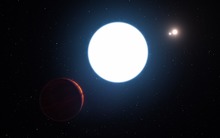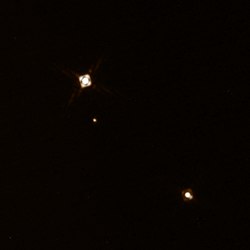HD 131399
| Observation data EpochJ2000EquinoxJ2000 | |
|---|---|
| Constellation | Centaurus |
| Right ascension | 14h54m25.30919s[1] |
| Declination | −34° 08′ 34.0412″[1] |
| Apparent magnitude(V) | 7.07[2] |
| Characteristics | |
| Spectral type | A1V + G + K[3] |
| Astrometry | |
| Radial velocity(Rv) | 0.30 ± 1.3[4]km/s |
| Distance | 351+15 −12ly (107.9+4.5 −3.7[5]pc) |
| A | |
| Proper motion(μ) | RA:−30.702[6]mas/yr Dec.:−30.774[6]mas/yr |
| Parallax(π) | 9.7480 ± 0.0357mas[6] |
| Distance | 335 ± 1ly (102.6 ± 0.4pc) |
| Absolute magnitude(MV) | 1.89[7] |
| BC | |
| Proper motion(μ) | RA:−31.523[8]mas/yr Dec.:−31.047[8]mas/yr |
| Parallax(π) | 9.3021 ± 0.0633mas[8] |
| Distance | 351 ± 2ly (107.5 ± 0.7pc) |
| Orbit[3] | |
| Primary | A |
| Companion | BC |
| Period(P) | 3556 ± 36yr |
| Semi-major axis(a) | 3.56 ± 0.03″ (349 ± 28 au) |
| Eccentricity(e) | 0.13 ± 0.05 |
| Inclination(i) | 45 to 65° |
| Longitude of the node(Ω) | 265 ± 20[note 1]° |
| Periastronepoch(T) | B502 ± 33 |
| Argument of periastron(ω) (secondary) | 145.3 ± 15[note 2]° |
| Details | |
| Age | 21.9+4.1 −3.8[5]Myr |
| HD 131399 A | |
| Mass | 1.95+0.08 −0.06[7]M☉ |
| Radius | 1.51+0.13 −0.10[7]R☉ |
| Luminosity | 14.8+2.6 −2.2[7]L☉ |
| Surface gravity(logg) | 4.37±0.10[7]cgs |
| Temperature | 9,200±100[7]K |
| Rotational velocity(vsini) | 26±2[7]km/s |
| HD 131399 B | |
| Mass | 0.95±0.04[5]M☉ |
| Surface gravity(logg) | 4.40±0.03[5]cgs |
| Temperature | 4,890+190 −170[5]K |
| HD 131399 C | |
| Mass | 0.35±0.04[5]M☉ |
| Surface gravity(logg) | 4.45±0.05[5]cgs |
| Temperature | 3,460±60[5]K |
| Other designations | |
| Database references | |
| SIMBAD | data |
HD 131399is astar systemin theconstellationofCentaurus.Based on the system's electromagnetic spectrum, it is located around 350 light-years (107.9 parsecs) away.[5]The totalapparent magnitudeis 7.07,[5]but because ofinterstellar dustbetween it and the Earth, it appears 0.22 ± 0.09 magnitudesdimmerthan it should be.[5]
The brightest star, is a youngA-type main-sequence star,and further out are two lower-mass stars.[3]AJupiter-mass planet or a low-massbrown dwarfwas once thought to be orbiting the central star, but this has been ruled out.[5][9]
Stellar system
[edit]The brightest star in the HD 131399 system is designated HD 131399 A. Its spectral type is A1V,[3]and it is 2.08 times as massive as the Sun.[5]The two lower-mass stars are designated HD 131399 B and C, respectively. B is aG-type main-sequence star,while HD 131399 C is aK-type main-sequence star.[3]Both stars are less massive than the Sun.[5]
HD 131399 B and C are located very close to each other, and the two orbit each other at about 10 AU.[10]In turn, the B-C pair orbits the central star A at a distance of 349astronomical units(au). This orbit takes about 3,600 years to complete, and it has an eccentricity of about 0.13[3]The entire system is about 21.9 million years old.[5]
One paper has reported that HD 131399 A has a companion in an inclined 10-day orbit with asemi-major axisof0.1AU.[11]HD 131399 A has been described as a "nascentAm star";although it has a very slow projected rotation rate and would be expected to showchemical peculiarities,itsspectrumis relatively normal, possibly due to its young age.[7]
Claims of a planetary system
[edit]
The claimed discovery of a massive planet, named HD 131399 Ab, was announced in a paper published in the journalScience.[3]The object was imaged using theSPHEREimager of theVery Large Telescopeat theEuropean Southern Observatory,located in theAtacama DesertofChile,and announced in a July 2016 paper in the journalScience.[3][12]It was thought to be aT-typeobject with a mass of4 ± 1MJ,[3]but its orbit would have been unstable, causing it to be ejected between the primary'sred giant phaseandwhite dwarfphase.[13]This was the first exoplanet candidate to be discovered by SPHERE. The image was created from two separate SPHERE observations: one to image the three stars and one to detect the faint planet.[14]After its discovery, the team unofficially named the system "Scorpion-1" and the planet "Scorpion-1b", after the survey that prompted its discovery, the Scorpion Planet Survey (principal investigator:Daniel Apai).[15]
In May 2017, observations made by theGemini Planet Imagerand including a reanalysis of the SPHERE data suggest that this target is, in fact, abackground star.This object'sspectrumseems to be like that of aK-typeorM-type dwarf,not a T-type object as first thought. It also initially appeared to be associated with HD 131399, but this was because of its unusually high proper motion (in the top 4% fastest-moving stars).[5]After subsequent data published in 2022 confirmed that the object is a background star, the paper announcing the putative discovery wasretracted.[9][16]
References
[edit]- ^abvan Leeuwen, F.; et al. (2007)."Validation of the new Hipparcos reduction".Astronomy and Astrophysics.474(2): 653–664.arXiv:0708.1752.Bibcode:2007A&A...474..653V.doi:10.1051/0004-6361:20078357.S2CID18759600.
- ^Høg, E.; et al. (2000). "The Tycho-2 catalogue of the 2.5 million brightest stars".Astronomy and Astrophysics.355:L27–L30.Bibcode:2000A&A...355L..27H.
- ^abcdefghiWagner, K.; Apai, D.; Kasper, M.; Kratter, K.; McClure, M.; Robberto, M.; Beuzit, J.-L. (2016). "Direct imaging discovery of a Jovian exoplanet within a triple-star system".Science.353(6300): 673–8.arXiv:1607.02525.Bibcode:2016Sci...353..673W.doi:10.1126/science.aaf9671.PMID27386921.S2CID206650422.(Retracted, seedoi:10.1126/science.abq1709,PMID35420970,Retraction Watch)
- ^Kharchenko, N. V.; et al. (2007). "Astrophysical supplements to the ASCC-2.5: Ia. Radial velocities of ~55000 stars and mean radial velocities of 516 Galactic open clusters and associations".Astronomische Nachrichten.328(9): 889.arXiv:0705.0878.Bibcode:2007AN....328..889K.doi:10.1002/asna.200710776.S2CID119323941.
- ^abcdefghijklmnopNielsen, Eric L.; et al. (2017)."Evidence that the Directly-Imaged Planet HD 131399 Ab is a Background Star".The Astronomical Journal.154(6): 218.arXiv:1705.06851.Bibcode:2017AJ....154..218N.doi:10.3847/1538-3881/aa8a69.S2CID55138870.
- ^abcBrown, A. G. A.;et al. (Gaia collaboration) (2021)."GaiaEarly Data Release 3: Summary of the contents and survey properties ".Astronomy & Astrophysics.649:A1.arXiv:2012.01533.Bibcode:2021A&A...649A...1G.doi:10.1051/0004-6361/202039657.S2CID227254300.(Erratum:doi:10.1051/0004-6361/202039657e).Gaia EDR3 record for this sourceatVizieR.
- ^abcdefghPrzybilla, N.; Aschenbrenner, P.; Buder, S. (2017). "Candidate exoplanet host HD 131399A: A nascent Am star".Astronomy & Astrophysics.604:L9.arXiv:1707.07920.Bibcode:2017A&A...604L...9P.doi:10.1051/0004-6361/201731384.S2CID119230582.
- ^abcBrown, A. G. A.;et al. (Gaia collaboration) (2021)."GaiaEarly Data Release 3: Summary of the contents and survey properties ".Astronomy & Astrophysics.649:A1.arXiv:2012.01533.Bibcode:2021A&A...649A...1G.doi:10.1051/0004-6361/202039657.S2CID227254300.(Erratum:doi:10.1051/0004-6361/202039657e).Gaia EDR3 record for this sourceatVizieR.
- ^abWagner, Kevin; Apai, Dániel; Kasper, Markus; Kratter, Kaitlin; McClure, Melissa; Robberto, Massimo; Beuzit, Jean-Luc (2022-04-15)."Retraction".Science.376(6590): 255.Bibcode:2022Sci...376..255W.doi:10.1126/science.abq1709.ISSN0036-8075.PMID35420970.S2CID248180563.
- ^"HD 131399Ab: Astronomers Find Super-Jupiter in Triple-Star System | Astronomy | Sci-News.com".Retrieved8 July2016.
- ^Lagrange, A.-M.; Keppler, M.; Beust, H.; Rodet, L.; Meunier, N.; Lillo-Box, J.; Bonnefoy, M.; Galland, F. (2017)."Discovery of a stellar companion to HD 131399A".Astronomy & Astrophysics.608:L9.Bibcode:2017A&A...608L...9L.doi:10.1051/0004-6361/201730978.
- ^"This strange new planet has three suns".CBS News.7 July 2016.Retrieved7 July2016.
- ^Veras, Dimitri; Mustill, Alexander J.; Gänsicke, Boris T. (2017)."The unstable fate of the planet orbiting the a star in the HD 131399 triple stellar system".Monthly Notices of the Royal Astronomical Society.465(2): 1499.arXiv:1611.00007.Bibcode:2017MNRAS.465.1499V.doi:10.1093/mnras/stw2821.S2CID73723946.
- ^"A Surprising Planet with Three Suns".ESO.Retrieved7 July2016.
- ^Miller, Michael (12 April 2017)."UC mountaineer, galactic explorer".UC Magazine.University of Cincinnati.Retrieved3 May2017.
- ^Oransky, Ivan (14 April 2022)."Triple sunrise, triple sunset: Science paper retracted when it turns out a planet is a star".Retraction Watch.Retrieved25 April2022.

